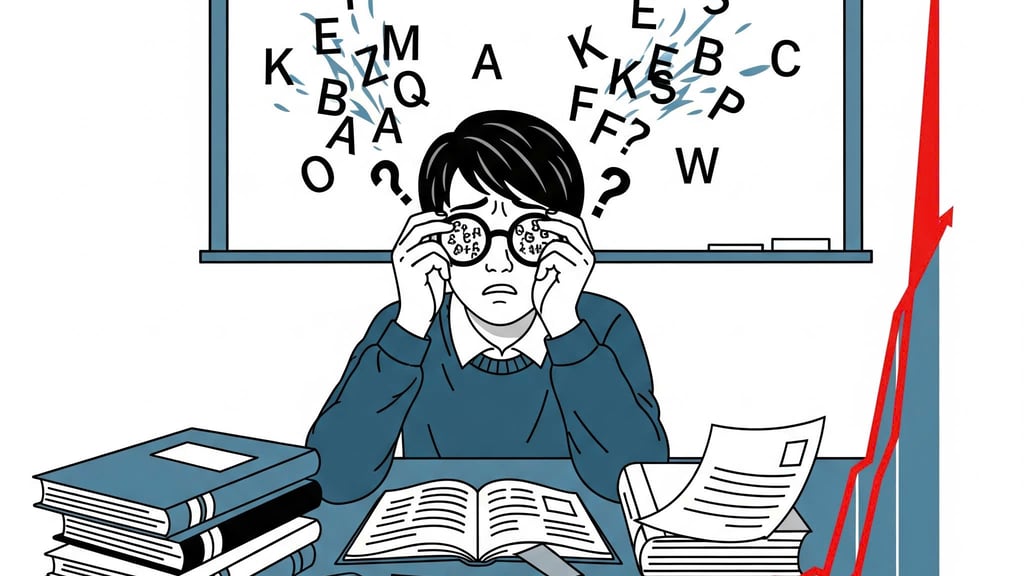How does myopia affect learning and exams? - Rapid increase in glasses prescription - a dangerous sign
3/10/20257 min read


Understanding Myopia
Myopia, commonly known as nearsightedness, is a refractive error in vision that causes distant objects to appear blurry while close objects can be seen clearly. This condition occurs when the eye is longer than usual or the cornea has excessive curvature, causing light rays to focus at a point in front of the retina instead of directly on its surface. The symptoms of myopia often manifest as difficulty in seeing distant objects, the need to squint to see clearly, or headaches resulting from eye strain after prolonged tasks such as reading or screen usage.
Myopia is increasingly prevalent, particularly among children and adolescents, prompting significant concern regarding its impact on learning and academic performance. Recent statistics indicate that around 30% of children in the United States are affected by myopia, with the rate rising sharply over the past few decades. The correlation between extended screen time, decreased outdoor activity, and the spike in myopia cases presents a crucial area of focus for educators and parents alike. Many studies suggest that the lack of exposure to natural light and the need for constant near-vision tasks contribute significantly to this trend.
Moreover, myopia has not only short-term effects on learning but may lead to long-term complications, including an increased risk of conditions like glaucoma, cataract, and retinal detachment. The increase in glasses prescriptions among students demonstrates a worrying trend, reinforcing the need for regular eye examinations and appropriate interventions. Educational institutions should therefore promote awareness regarding the importance of eye health and encourage regular breaks from close-up tasks to mitigate the detrimental effects of myopia on children’s learning experiences.
The Impact of Myopia on Learning
Myopia, commonly referred to as nearsightedness, poses significant challenges for children in their educational journeys. The inability to see distant objects clearly can hinder a child's ability to view educational materials, such as blackboards or whiteboards during class. This often leads to increased difficulties in following along with lessons and comprehending instructional materials. As a result, children may struggle to participate fully in classroom activities, impacting their overall learning experience and academic performance.
Studies have shown a strong correlation between uncorrected vision problems, such as myopia, and decreased academic achievement. Research indicates that children who suffer from refractive errors often experience drops in grades, particularly in subjects that require a premium on visual acuity, such as mathematics and science. The inability to clearly see what is being taught can lead to gaps in understanding that negatively affect long-term educational outcomes. Children with unaddressed myopia may also develop feelings of frustration and disengagement, further exacerbating their learning difficulties.
Moreover, the impact of myopia is not only limited to academic performance but also extends to social interactions within the school environment. Children struggling with vision issues might isolate themselves or avoid participating in group activities, leading to possible emotional consequences, including low self-esteem and increased anxiety. This social dimension of learning is crucial, as collaboration and peer engagement are essential components of a well-rounded educational experience.
In light of these factors, it is essential to address myopia promptly through appropriate corrective measures, such as eyeglasses or contact lenses. Early intervention can significantly ameliorate the impact of myopia on learning, allowing children to better engage with their educational environments and thrive academically and socially.
Myopia and Exams: The Pressure to Perform
Myopia, also known as nearsightedness, has significant implications for students, particularly during exam situations where visual acuity is paramount. The experience of myopic students during assessments often manifests through a series of challenges that can adversely affect their performance. Many students with myopia report difficulties in reading distant materials, such as exam instructions projected on a screen or the clock indicating the remaining time. Such challenges necessitate the need for adjustments and accommodations for these individuals, such as extra time or enlarged print, which can also add an extra layer of pressure.
Furthermore, myopic students frequently experience heightened anxiety related to their visual limitations. The stress of not being able to clearly see their exam papers or understand questions can lead to a lack of confidence. This stress is compounded by the competitive nature of academic settings, pushing myopic students to overcompensate in their preparations. One student, Maria, shared her experience of struggling to read the board during an important examination, which left her feeling frustrated and anxious. As a result, she struggled not only with the content but also with the growing pressure that stemmed from her visual impairment.
Research suggests that students with uncorrected myopia may perform less effectively in examinations than their peers with normal vision. This could be attributed not only to the physical strain but also to the psychological impact of managing a visual deficit in a high-stakes environment. Another case to highlight is Alex, who required glasses but waited too long to address his condition. His results were significantly affected, leading to a decreased interest in subjects he used to enjoy. Overall, addressing the needs of myopic students is crucial in the educational landscape, ensuring fair assessment and better learning outcomes, while providing adequate support systems to alleviate these pressures.
Rapid Increase in Glasses Prescription
The surge in glasses prescriptions among students has become a notable concern in contemporary education, particularly regarding those affected by myopia, or nearsightedness. Recent statistics reveal that there has been a marked increase in the number of children and adolescents requiring corrective eyewear over the past decade. According to the American Optometric Association, the prevalence of myopia in school-aged children has escalated significantly, with about one in four having some degree of myopia by the age of 17. This alarming trend indicates not only an increase in the incidence of myopia itself but also a compounding effect on eye health and overall learning capabilities.
Several studies suggest that environmental factors, such as extended screen time, less time spent outdoors, and increased academic pressures, are contributing to this rise in prescriptions. Research published in the journal Ophthalmology highlights that modern lifestyles, predominantly characterized by digital engagement, can lead to visual stress, resulting in exacerbated myopia rates. Furthermore, the increase in dependence on digital devices for education and social interaction limits opportunities for natural light exposure, which is crucial for maintaining healthy eyesight.
The implications of this growing trend extend beyond mere vision correction. With myopia often worsening over time, there is an increased risk of developing more severe ocular conditions later in life, such as retinal detachment and glaucoma. As prescription rates continue to climb, educators and parents need to recognize the signs of myopia among students and consider proactive strategies to combat the issue. Such strategies may include promoting outdoor activities and implementing regular eye examinations to monitor visual changes. Addressing this public health concern is essential for ensuring that students can learn and perform optimally in academic settings without the hindrance of unresolved visual challenges.
Identifying Dangerous Signs
Myopia, commonly referred to as nearsightedness, can significantly impact students’ learning experiences and overall academic performance. One of the first steps in mitigating the effects of myopia is the early identification of its progression through the recognition of several warning signs. Parents and educators should be vigilant for symptoms that might indicate a concerning development in a child's eyesight.
Common symptoms of myopia include difficulty seeing distant objects clearly, squinting while attempting to read signs or a blackboard, and frequent eye rubbing complaints of headaches. Additionally, students may demonstrate frustration during reading tasks or while engaging in outdoor activities, often resulting from the inability to see objects clearly at a distance. Recognizing these symptoms early is crucial, as untreated myopia can lead to further deterioration of vision and associated learning challenges.
Regular eye examinations are essential in identifying these potential issues before they escalate. Eye care professionals typically recommend that children undergo their first comprehensive eye exam by the age of five, with subsequent evaluations every one to two years, depending on their specific needs. These eye exams can help detect myopia at its initial stages or monitor its progression, allowing for timely intervention. Proactive measures such as implementing proper corrective lenses or assessing environmental factors like screen time and reading habits can contribute significantly to managing myopia effectively.
Furthermore, education about myopia for parents and educators is essential. Understanding the implications of myopia on learning and academic performance can empower caregivers to act swiftly if symptoms arise. Addressing myopia proactively not only helps preserve a child's vision but also supports their educational journey, ensuring they can engage with their learning environment fully and effectively.
Preventive Strategies and Solutions
As myopia continues to rise, particularly among students, it is critical to adopt preventive strategies that can mitigate its progression. One highly recommended approach is increasing outdoor activities. Research indicates that spending time outside can significantly reduce the risk of developing myopia. Natural light exposure is believed to play a vital role in healthy eye development, and encouraging children and adolescents to engage in outdoor play can be an effective preventative measure.
In addition to outdoor activities, incorporating eye exercises into daily routines can help maintain eye health. Techniques such as the 20-20-20 rule suggest that for every 20 minutes spent looking at a screen or reading, individuals should take a 20-second break to look at something at least 20 feet away. This method allows the eyes to relax, reducing strain and potentially slowing the worsening of myopic symptoms.
Proper lighting conditions while studying or engaging in close-up activities are equally important in preventing the exacerbation of myopia. It is crucial to ensure that study environments are well-lit to minimize eye strain. Task lighting, adjustable desks, and appropriate distance from screens or books can enhance comfort during study sessions.
Regular eye check-ups are essential for early detection and management of myopia. Routine visits to an eye care professional enable timely prescriptions and monitoring of any changes in vision. Eye specialists can offer personalized guidance and recommend beneficial interventions tailored to individual needs.
Modern solutions such as myopia management therapies, including orthokeratology and atropine eye drops, are proving to be effective in controlling the progression of myopia in children and adolescents. These treatments can complement lifestyle changes, promoting healthier visual habits and preserving eyesight for the future.
Conclusion: The Path Forward
In light of the alarming rise in myopia cases and its direct impact on learning and examination performance, it is crucial to recognize the broader implications of this condition. Myopia not only affects visual acuity but also poses significant challenges to students' educational experiences. As the prevalence of myopia increases, particularly among children and adolescents, the importance of understanding its effects on academic achievement cannot be overstated.
Awareness is the first step toward addressing the myopia epidemic. Educators, parents, and health professionals must collaborate to identify students who may be struggling with undiagnosed vision problems. Early detection and intervention are vital in preventing further deterioration of sight and ensuring that students can engage fully in their educational pursuits. This may involve regular eye examinations and discussions about visual health in school settings.
Moreover, preventive measures are essential. Encouraging healthy visual habits can significantly reduce the risk of developing myopia. Simple actions, such as ensuring adequate outdoor time, limiting screen exposure, and promoting proper reading posture, can contribute to better eye health. Communities should focus on fostering environments that prioritize these habits for their youth, thereby reducing the incidence of myopia.
Ultimately, addressing this issue requires a collective effort. Schools, families, and health care providers must come together to create a supportive network for students. By raising awareness, promoting preventive practices, and ensuring equitable access to eye care, we can work toward mitigating the effects of myopia on learning. Through concerted action, we can pave the way for improved educational outcomes and a healthier future for young learners facing the challenges of myopia.
